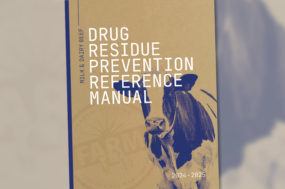What do cell phones, iPods and heat detection have in common? The same technology that changes the screen on your iPod or Smart Phone when you move your phone from horizontal to vertical is the same technology helping to detect heat in dairy cattle. That technology is known as the accelerometer and it is the most recent electronic system to be marketed to dairy farmers for the purpose of monitoring physical activity with estrous behavior.

Paul Fricke (right) of the University of Wisconsin-Madison was involved with a recently completed study that looked at the use of accelerometer systems for detection of estrus and timing of AI in lactating dairy cows. In recent years, despite the widespread use of hormonal synchronization protocols, behavioral estrus still plays a very important role.
Challenges of estrus detection are prevalent because of a weaker duration of estrus behavior associated with “increased milk production near the time of estrus resulting in shorter periods of time in which to visually detect estrous behavior,” says Fricke.
A low number of cows showing standing heat, silent ovulations, and reduced expression of estrous behavior due to confinement add to the problem.
It is believed that this study is the first of its kind looking at the effectiveness of accelerometer systems.
Older pedometer systems simply measured the number of steps a cow took throughout the day, whereas accelerometers measure motion in three dimensions. That information is downloaded at milking times via a wireless transmitter, and the software analyzes the information.
Standing mounts are still the primary sign of heat, but increased activity is a good secondary sign.
The study took place over 12 months at a 1,000 cow Wisconsin dairy. Each week 10 to 15 cows that were 46 to 52 days in milk were evaluated by ultrasound and cows determined to be in good uterine health and with at least one follicle at least 10 mm in diameter received an injection of GnRH followed by an injection of PGF seven days later.
Cows were ultra-sounded at the time of the PFG injection, 48 hours after the PFG injection, and then every eight hours until ovulation occurred, or 96 hours, whichever came first.
A total of 112 cows were enrolled in the study, and 89 of those were considered properly synchronized to be included in the data.
Overall, the study showed the accelerometer detected cows in estrus 71 percent of the time, and 95 percent of the cows showing estrus ovulated within seven days of induction of luteolysis. Of the cows that the accelerometer did not detect estrus, 35 percent ovulated within days of induction of luteolysis.
“The percentage of cows that failed to ovulate within the group of cows not detected in estrus was 65 percent for the accelerometer system, suggesting that estrus did not occur in these cows,” the study results state. “The remaining 35 percent of ovulations in cows not detected in estrus may have been silent ovulations (ovulation without estrus), a phenomena described in lactating dairy cows especially during the early postpartum period.”
The duration of estrus activity for cows detected in estrus by the accelerometer system was not affected by the number of lactations, or milk production near the time of estrus.
“We did not expect that approximately 30 percent of the cows would fail to show estrus within seven days after the PFG injection, because a follicle more than 10 mm was present in all cows at the time of the PFG injection, and all cows included in the analysis underwent luteal regression within 48 hours after PFG treatment,” says Fricke.
There was an average interval of 28.7 hours from the onset of activity to ovulation, but there was a very wide variation. Fricke says it is best to breed cows eight to twelve hours before ovulation. The mean interval between AI and ovulation in the study was 7.9 hours.
“Using just an accelerometer system you will never catch all cows in estrus,” says Fricke. “In my mind a blended approach is the way to go, blending activity monitoring and a sync program.”
The study concludes, “These data underscore the importance of implementing a comprehensive reproductive management program for identification and treatment of cows that would otherwise not be inseminated, and to identify those cows failing to ovulate when cycling spontaneously. Based on data from the present experiment using this accelerometer system, the mean time of AI in relation to ovulation was acceptable for most of the cows detected in estrus; however, variability in the duration of estrus and timing of AI in relation to ovulation could lead to poor fertility in some cows.” PD
Kelli Boylen is a freelance writer based in Waterville, Iowa.




